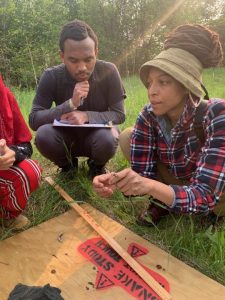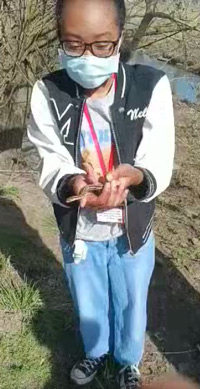“Now that we see this [snake] population here, it gives support to our efforts to conserve this place that these animals call home” – Mars Patterson, Nearby Nature Land Steward
Nearby Nature Milwaukee began a serious wildlife habitat study in Hopkins Hollow this Spring. It’s a part of a new agreement we made with MMSD to allow us to study birds, bats, snakes, toads and more. The data we are collecting will allow us to do several things. First, it will verify the rich variety of wildlife that this wild area supports. Second, in the future we can repeat this study to see if our restoration efforts, and increased activity on the site, have any impact on the wildlife. Third, it will inform our educational work, as we share the data with the community and school groups that come to visit the area.

Hanan Ali, Hassan Richardson and Mars Patterson inspect a snake in Hopkins Hollow
During a recent weekly check on the “snake boards” spread throughout the area, Phillip Boudreaux, a reporter from Spectrum Cable News filmed and interviewed Mars Patterson and other staff while they conducted the study. You can view the video at this link. In total, there are 24 sheets of plywood spread in three different areas of the 20 acre space. Each week, staff and volunteers lift the boards, quickly and gently capture the snakes and analyze them on-by-one. The team checks them for length, gender, and any special markings before returning them to their habitat. Most of the snakes are Butler garter snakes. This snake species was once listed as a species of concern, as urban development reduced its habitat. It’s interesting to note that around the year 2000, prior to construction that removed a concrete lined channel, the MMSD hired a local herpetologist to capture and preserve the snakes.

Nearby Nature’s “Nature Artist in Residence” Youth programs on a visit to Hopkins Hollow
After the construction, the snakes were provided with two man-made snake dens to support them while the re-acclimated themselves to the space. Two of three study areas are near the dens that were built 20 years ago. A third study area turned out to be property owned by Milwaukee County Parks. Brian Russert, County Parks chief naturalist, quickly provided us permission to continue the study on that parcel.
Participating in the snake study are our four summer land stewardship interns. This is just one of many activities that offering a wide range of experiences in stewardship, outdoor recreation and green career exploration. Another story we like to relate is how students in our youth programs react to snakes. Initially, nearly every kid will tell you they do not like snakes, but after watching Mars gently handle them and talk about them, the kids invariably line up to touch or ask to hold the snake themselves. For these young folks, curiosity is one of thier superpowers we like to foster. Watch this Facebook video of kids learning to handle snakes, from a Carmen School field trip to Hopkins Hollow. These wildlife studies are supported with technical assistance from both professionals and volunteers. While our youth and internship programs are fully funded from other sources, this particular research is being funded by a grant from the Natural Resources Foundation of Wisconsin. We are grateful for this support.

Recent Comments